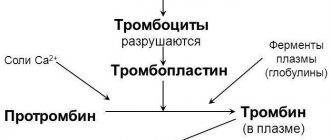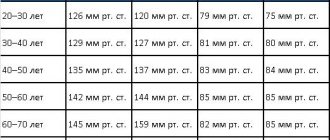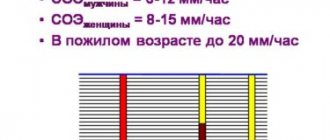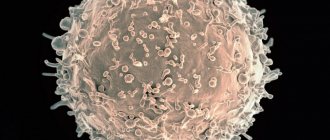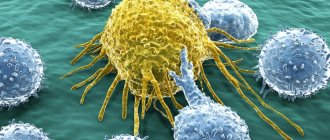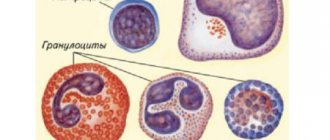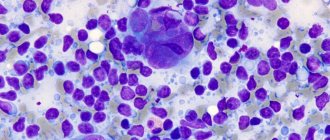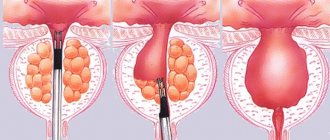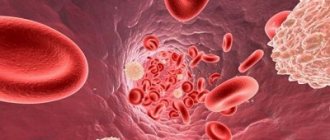General blood tests
04/03/201801/24/2019 Yulia Martynovich (Peshkova) 2819 Views lymphocytes, general tests
It is very difficult to overestimate the role of lymphocytes in making a diagnosis and protecting a person. This is one of the first indicators that responds to infectious infection, the development of a malignant neoplasm, allergies or the negative effects of medications. Also, lymphocytes (normal in men and women) depend on the age of the patient.
Before you figure out what is the danger of lymphocytes deviating from the norm, you need to understand: what kind of cells are they and what functions do they perform?
- 1 Lymphocytes and their functions
- 2 Indications for analysis
- 3 Norms of lymphocytes in the blood of men 3.1 Norms of various types of leukocytes
Lymphocytes and their functions
Lymphocytes are one of the types of white blood cells (leukocytes). A common feature for all leukocytes: the presence of a formed nucleus and the absence of the cell’s own color. Depending on the morphology, it is customary to distinguish between large granular cells and small cells without granules. Each type of lymphocyte performs its own function, however, the general functionality is reduced to protecting the human body from infections and its own mutant cells.
According to the functional classification, lymphocytes are divided into three groups, which are presented in the table.
| Type | Functions | Place of synthesis |
| B cells | Production of protein antibodies that are strictly specific to foreign antigens | During fetal development - bone marrow and liver, after birth - bone marrow |
| T cells | T helper cells are involved in the activation of other immune cells; stimulate the production of antibodies | Thymus |
| T-suppressors determine the duration of the immune response and its severity | ||
| Natural killers | Destroy infected and cancer cells | Formed from lymphoblasts - cells that have not yet come into contact with foreign antigens |
The number of lymphocytes is determined as part of a general blood test (sodium lauryl sulfate method) or leukocyte formula (flow cytometry). The period for obtaining analysis results does not exceed 1 day.
Causes of lymphocytosis
An increase in the number of lymphocytes in the female body with a normal number of other immune cells is a sign of certain pathologies. A list of common abnormalities and diseases is presented:
- ARVI - lymphocytes belong to the mechanisms of protective properties in the body, which are the first to encounter pathogenic microflora. During the acute phase of the disease, the maximum number of cells is observed, with no activity in other immune structures.
- Rheumatic pathologies - systemic or local lesions of connective tissues are associated with unknown triggers. Experts agree that the main source of their development is bacterial.
- An excess of hormonal substances from the thyroid gland - a disorder provokes the development of autoimmune diseases. The defense system stops recognizing its own and foreign cells and attacks them equally.
- Chronic adrenal insufficiency is a pathological process that is a consequence of bacterial infections or chemical poisoning.
- Abnormal size of the spleen - the problem is directly related to the root causes of the deviation. Minor changes occur due to infection or autoimmune disease, serious changes occur due to malaria and other diseases.
Not all sources of disorders that provoke pathology have been fully identified. These reasons are considered the most common.
Indications for analysis
A man can receive a referral for testing from a general practitioner, infectious disease specialist, urologist, surgeon or hematologist. Determining the level of lymphocytes in the blood is relevant if necessary:
- general clinical routine examination;
- preparation for surgical intervention of any degree of complexity;
- symptoms of infectious or parasitic infection (fever, cough, nausea, weakness, pain of various localizations);
- primary diagnosis of an allergic reaction and determining the degree of its severity;
- identifying leukemia and assessing the effectiveness of selected treatment methods;
- suspected cancer;
- suspicion of various immunodeficiencies;
- diagnosing side effects of medications during long-term use.
The norm of lymphocytes in the blood of men
Important: decoding lymphocytes in the analysis is the task of the attending physician, while normal values are selected taking into account the gender and age of the subject.
Self-diagnosis is dangerous due to incorrect definition of the disease and the necessary treatment methods, which can subsequently lead to a significant deterioration in the man’s health.
The standard norms of lymphocytes in men by age, given in the table, are for informational purposes only and cannot serve as a basis for self-diagnosis of the patient.
| Age | The norm of lymphocytes in men as a percentage of the total number of leukocytes |
| 0 – 1 year | 40 – 75 |
| 1 – 2 years | 35 – 65 |
| 2-4 years | 35 – 60 |
| 4 – 6 years | 30 – 55 |
| 6 – 8 years | 30 – 50 |
| 8 – 10 years | 25 – 45 |
| 10 – 15 years | 25 – 40 |
| 15 – 50 years | 17 – 35 |
| Over 55 years old | 15 – 30 |
It should be noted that standard values for infants are significantly higher than for older children. An increase in the number of lymphocytes is necessary to provide natural immunity to the child until the acquired one is fully formed.
Starting from the age of 55, men may experience slight lymphopenia - a decrease in the content of white blood cells in the blood, which is a variant of the physiological norm.
Norms of different types of leukocytes
Along with lymphocytes, patients are often interested in the question: what is the normal range of basophils and eosinophils, as well as other types of leukocytes?
The number of basophils in people should not exceed 1.5% of the total number of white blood cells; the value of the indicator does not depend on gender or age.
The eosinophil content up to 1 year is 1–5%, from 2 to 4 years – no more than 6%, and then the criterion should be in the range from 1 to 5% of the total leukocyte concentration.
The norm of monocytes for an infant is no more than 10%, for patients older than 2 years – from 3 to 13%.
Standard neutrophil values for children under 1 year of age are from 15 to 46%, from 1 to 16 years of age - from 25 to 60%, over 16 years of age - from 45 to 75%.
Read further: If neutrophils are low and lymphocytes are high in an adult
Types of lymphocytosis
An increase in the number of lymphocytes in women is associated with a major source of dysfunction. Experts identify several types of pathology:
- Reactive – provoked by diseases that cause disruption of the functionality of the immune system. The list is presented: infectious mononucleosis, tuberculosis, syphilis, HIV infection, severe depletion of the body. To normalize test results, it is necessary to carry out therapy for the infectious disease.
- Malignant – cancerous tumors provoke the formation of acute or chronic lymphocytosis. The phase of the disease directly depends on the stage of development of the neoplasm.
- Post-infectious – deviations in tests are caused by previous infections. Lymphocytosis is accompanied by influenza, chickenpox, rubella, hepatitis, scarlet fever, and measles.
A sharp increase in the number of lymphocytes in the blood should alert a woman. Sometimes deviations make it possible to timely detect latent pathological processes or the initial stages of malignant neoplasms. Small changes should not be ignored; patients need to reconsider their usual diet, eliminate bad habits, and do not forget about seasonal vitamin therapy.
Elevated lymphocytes in the blood of men - what does this mean?
It should be noted that a slight deviation of the criterion from normal values has no diagnostic value and can be caused by a number of reasons:
- improper preparation for the delivery of biomaterial;
- daily fluctuations of all laboratory criteria in the human body;
- errors at the preanalytical stage;
- errors of the instruments used.
In this case, an increase in lymphocytes in the blood of men is a variant of the physiological norm and has no diagnostic value. A repeat study is scheduled after 1–3 days.
If the number of lymphocytes exceeds the standard values by 10 or more units, then a comprehensive plan for examining the patient is determined to determine the presence of various pathologies. Possible causes of increased levels of lymphocytes in the blood in men:
- infectious disease of a viral, bacterial or parasitic nature;
- non-infectious inflammatory process;
- oncological pathologies affecting the functioning of the bone marrow, lymphatic and circulatory systems;
- acute stage of the allergic response of the human body;
- intoxication with carbon disulfide, arsenic, mercury or other substances, including psychotropic and narcotic substances;
- long-term use of medications related to anticonvulsants or antiepileptics.
Main article: What do elevated lymphocytes in an adult indicate, what are the reasons, and what to do?
Features of lymphocytosis
The term indicates disturbances in the functioning of the female body, the activity of the immune system to combat intrusions:
- bacteria, viruses;
- protozoa, parasites.
Other reasons for an increased concentration of lymphocytes include their damage or death due to:
- burn disease;
- tissue necrosis;
- inflammatory processes;
- allergies;
- autoimmune diseases;
- oncological pathologies.
Cells reach problem areas, but with further progression of the disease they begin to die en masse.
The chronic form of lymphocytosis is the result of diseases of the blood or hematopoietic system, lymphatic department. Taurus do not fully mature and cannot fully perform the functions assigned to them. To normalize the balance, the bone marrow produces even more lymphocytes, but the benefits from the increased work are minimal.
The accumulation of protective cells may be due to problems with their utilization in the spleen. Doctors believe that it is not deviations in tests that are of greatest importance, but the sources of their occurrence. Dysfunction of the immune system leads to the development of chronic infections, autoimmune diseases with attacks on one’s own cells, the formation and further proliferation of atypical structural units.
Decreased lymphocytes
Patients ask themselves: what is the danger of a low lymphocyte count? The danger of this condition is due to the inhibition of the natural defenses of the human body. It can be a consequence of autoimmune pathologies, infection with the human immunodeficiency virus (HIV) or malignant lesions of the circulatory system.
It is important to note that during the acute stage of a bacterial or viral infection, the size of lymphocytes often decreases. The reason is the rapid death of protective cells when fighting infection, while new lymphocytes do not have time to be produced in sufficient quantities. In this case, in addition to antiviral drugs, the doctor prescribes immunostimulating drugs.
Read further: Lymphocytes are low - what does this mean and how to treat?
How to prepare for the analysis?
The accuracy and reliability of the results obtained depends on the correct preanalytical preparation of the patient. The biomaterial for analysis is venous blood serum taken from a vein in the bend of the elbow. It is important to donate blood while sitting.
The biomaterial is collected strictly on an empty stomach (at least 8 hours break after the last meal), the optimal time is from 8 to 11 am. It is recommended to give up fatty, fried and spicy foods for 1 day; alcohol is prohibited. You are allowed to drink unlimited amounts of unsweetened water.
Physical and emotional stress should be limited as this may affect lymphocyte concentrations and lead to false test results. If you plan to go to the laboratory in the morning, it is not recommended to attend sports training the night before. Smoking is prohibited half an hour before blood collection.
For 2 days, the intake of any medications is limited, by prior agreement with the attending physician. This rule is especially important for drugs that thin the blood, for example, aspirin, phenylin, aspecard. The impossibility of discontinuing vital medications determines the need to notify the laboratory employee.
table 2
| Index | x 109/l | % |
| Band neutrophils | 0,04-0,3 | 1-6 |
| Segmented neutrophils | 2-5,5 | 45-72 |
| Basophils | up to 0.065 | up to 1 |
| Eosinophils | 0,02-0,3 | 0,5-5 |
| Lymphocytes | 1,2-3 | 19-37 |
| Monocytes | 0,09-0,6 | 3-11 |
The results of a general blood test (Table 1) show many indicators. Let's consider the main ones:
- RBC – total number of red blood cells (erythrocytes). The pathological increase in these cells is associated with impaired hematopoiesis. A decrease in red blood cells is usually a consequence of anemia, hemolysis and blood loss.
- HGB stands for hemoglobin, which is a protein containing iron. It transports oxygen to tissues, and carbon dioxide from them, and also maintains acid-base balance. A decrease in hemoglobin most often occurs due to anemia.
- HCT – hematocrit. It is defined as the ratio between the red blood cells that have settled to the bottom after taking the test and the total blood volume. An increase in this indicator indicates polyuria, erythrocytosis or erythremia. A decrease in hematocrit level occurs with anemia and an increase in circulating blood volume.
- PLT – platelets. These cells are responsible for blood clotting. If their number decreases, then the cause may be viral diseases, bone marrow lesions, bacterial infections and other pathologies. An increase in the number of platelets is caused by a wide variety of ailments: from joint diseases to cancer.
- CPU – color indicator. It determines the saturation of red blood cells with hemoglobin. If it is insufficient, this may indicate iron deficiency anemia, anemia or lead poisoning. When CP rises above normal, the cause is oncology, gastric polyposis and deficiency of vitamins B9 and B12.
- Erythrocyte indices: MCV - average volume of erythrocytes, used to determine water-salt balance and type of anemia;
- RDW is the degree of red blood cell diversity, which determines how different cells differ from each other in volume;
- MCH – average hemoglobin content in erythrocyte; this criterion is considered analogous to the color indicator;
- MCHC – average concentration and content of hemoglobin in red blood cells; this indicator is calculated taking into account the level of hematocrit and hemoglobin.
Now let's move on to the leukocyte formula (Table 2). It determines the percentage of different types of white blood cells in the blood, that is, the relative content of each type of white cell. What is this formula for? It is very important because with any changes in the body, the percentage of certain types of white cells in the blood decreases or increases. This is associated with a decrease or increase in other types. Based on the information obtained from the leukocyte formula, one can judge the course of a particular pathology, the occurrence of complications, and also more accurately predict the outcome of the disease.
